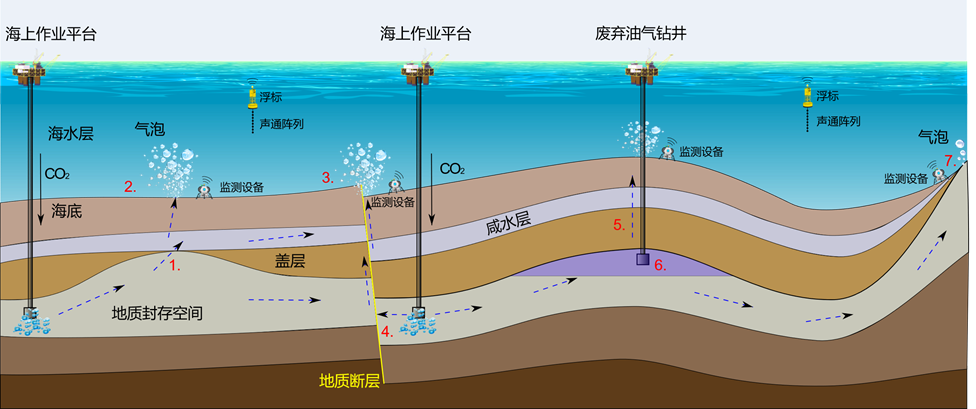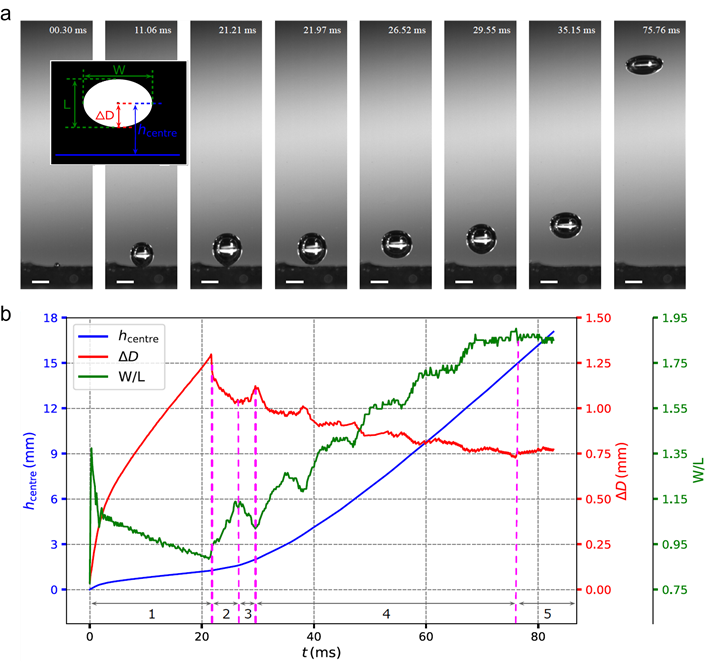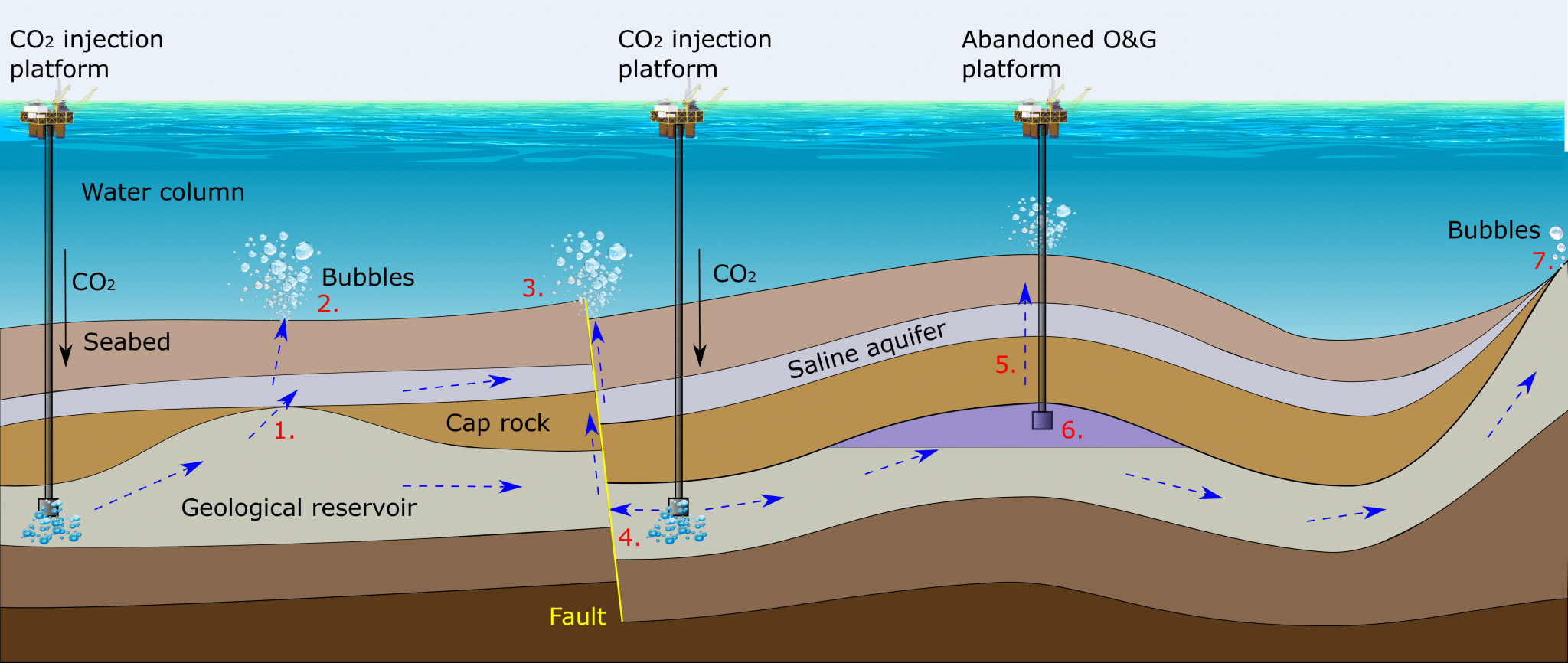中国大陆有13个沿海省级行政区,其总面积不足全国的14%,二氧化碳(CO2)排放量却占据了全国总排放量的41%。离海岸不远是我国11个近海沉积盆地,面积170万平方公里,为沿海省份提供了超过100年的大规模地质碳封存空间。为彻底解决CO2向大气排放的问题,离岸碳捕集、利用与封存(CCUS)作为一项重要的碳减排技术已被我国纳入实现碳中和目标愿景的重要解决方案,其工作机理为将工厂废气中的CO2捕集、压缩、通过海运或管道输送至封存平台,进而注入到海底地质空间永久封存。
在对海底碳封存复杂环境空间评估和安全保障中,水下声学监测与信号处理技术发挥着独特而关键的作用。对复杂海洋环境下海底声学监测信号的及时处理和稳健传输,是促进智慧海洋科技前沿发展的重要手段,也是实现我国国家安全保障的重要技术支撑。
李姜辉博士长期从事复杂海洋环境下声学监测与信号处理领域的研究工作,致力于解决海底碳封存环境安全声学监测问题(图1),其研究利用主动声学反向散射模型厘清海床固-液界面空间气体渗漏阶段特性,分析影响复杂海洋环境下海底气泡振动发声预警阈值确定的关键因素,实现海底碳封存区水下风险预警信号的稳健声学传输,力求在复杂海洋环境下实现海底碳封存环境安全声学监测的理论与方法的突破。

【图 1:海底碳封存环境安全声学监测场景。利用水下气泡声学进行海底声学环境主被动信息采集、处理与分析;利用水声通信对海底声学信息处理结果进行水下安全信号传输。】
李姜辉博士的在研项目之一 ---“碳中和”联合专项“海洋碳封存环境动态监测体系原型关键技术研究”针对海洋碳封存区域环境物理参数的长期原位测量、风险评估、阈值警报等难题,围绕信息化与智能化这一总体解决思路,研究海底碳封存空间盖层底质构造、海底表面气态CO2渗漏形式及气泡成型机理(图2)、环境基线浮动条件下风险参数特征与时空协同预警等问题,拟突破环境声学阈值无线预警等关键技术,验证理论与方法的正确性和关键技术的可行性,为建立长期碳封存环境科学监测体系原型提供技术支撑,进而为规模化利用海底地质空间封存CO2奠定重要决策基础,有望为我国及全球的海洋碳封存安全技术发展提供坚实的科学理论和有效的方法支撑。

【图2:(a)海底气体渗漏气泡形变过程中;(b)各量化参数的变化趋势。】
李姜辉博士于2011年获得华中科技大学通信工程学士学位,随后加入中国科学院任研究助理。他分别于2013、2017年获得英国约克大学通信工程硕士、电子工程博士学位。在海外留学期间,他于2016年获得国际电气与电子工程师协会海洋工程奖学金(Scholarship),并于2017年获得K.M.Stott科学奖。李姜辉博士随后在英国南安普顿大学和英国国家海洋学中心任研究员。2021年3月入围英国皇家工程院青年学者基金(Research Fellowship)资助名单。2021年7月加入4166金沙之选主页通道海洋与地球学院任教授,同年11月加盟近海海洋环境科学国家重点实验室。
李姜辉博士已为国家发改委、环境与发展国合会、以及亚洲开发银行撰写“碳中和”相关政策建议报告多篇,并于2021年11月创办“海洋碳封存环境与信息技术论坛”。其目前正积极组建“海洋碳封存”多学科交叉研究团队。欢迎访问其个人主页https://mel2.xmu.edu.cn/faculty/JianghuiLi/或通过Email联系:jli@xmu.edu.cn。
Dr. Jianghui Li --- A Young Scientist Working on Marine Carbon Storage
There are 13 provinces along the coast of the Chinese mainland. Although they occupy less than 14% of the nation's territorial area, they produce 41% of the country's annual CO2 emissions. Not far from the coast are 11 offshore sedimentary basins that provide potential large-scale carbon storage reservoirs and sufficient permanent geologic sequestration capabilities for more than 100 years' of carbon storage, potentially addressing long-term greenhouse gas emissions. To realize one-off greenhouse gases removal, the produced CO2 is expected to be captured, compressed, and transported via ship or pipeline to offshore platforms and injected into sub-seabed reservoirs for permanent isolation from the atmosphere. Thus, a technically feasible method of offshore CCUS (Carbon Capture, Utilization, and Storage) is possible. To ensure the CO2 is permanently locked inside the sub-seabed geological reservoir, environmental monitoring is necessary, in which underwater acoustic monitoring and signal processing plays a unique and key role in guaranteeing the safety of the ocean environment.
Dr. Li focuses on the environmental monitoring of marine carbon storage using acoustic tools (Figure 1), studies the application of active acoustic modeling to investigate the characteristics of gas leakage at the sediment-water interface, analyzes the key factors influencing the determination of gaseous bubble vibration and acoustic radiation in the marine environment, and develops robust underwater acoustic transmission links for safety warning signals.

【Figure 1. Potential gaseous bubble leakage routes for CO2 injected into geological reservoir.】
One of Dr. Li's research projects – a "Carbon Neutrality" focused project entitled "Prototype of Adaptive Environmental Monitoring for Marine Carbon Storage" aims to solve scientific problems such as long-term in-situ measurement, risk assessment, and thresholds of environmental hazards in the marine carbon storage area, and studies the spatial structure of sub-seabed storage reservoirs, undersea gas leakage and mechanism of gaseous CO2 bubble formation on the seabed (Figure 2), the risks under the floating environmental baseline condition and spatio-temporal collaborative early warning. He hopes to make breakthroughs in key technologies involving acoustic thresholding for wireless early warning, verify the correctness of theories and methods and the feasibility of key technologies, and provide technical support for establishing a prototype for a long-term carbon storage environmental monitoring system. The investigated theories and techniques are expected to build a foundation for decision-making for large-scale sub-seabed storage of CO2.

【Figure 2 The tendency of quantitative parameters in the process of gases bubble deformation at the sediment-water interface.】
Dr. Jianghui Li received his Bachelor's degree in Communications Engineering from Huazhong University of Science and Technology in 2011 and then joined the Chinese Academy of Sciences as a Research Assistant. In 2013 and 2017, he received his Master’s degree in Communications Engineering and Ph.D. in Electronic Engineering from the University of York, UK. During that time, he was the first recipient of the IEEE Oceanic Engineering Society (OES) Scholarship in the UK (2016) and received the K.M. Stott Prize for excellent scientific research in 2017. After that, he served as a Research Fellow at the University of Southampton and the National Oceanography Center. In March 2021, he was shortlisted for a Research Fellowship at the Royal Academy of Engineering; in July 2021, he joined Xiamen University as a Professor and became a faculty member of the State Key Laboratory of Marine Environmental Science (MEL) in November 2021.
To date, Jianghui has contributed to a number of policy recommendations on "Carbon Neutrality" for the National Development and Reform Commission, the China Council for International Cooperation on Environment and Development, and the Asian Development Bank. In November 2021, he founded the CCUS forum “Marine Carbon Storage: Environment and Information Technology". He is also actively preparing for the establishment of a multidisciplinary research team on "Marine Carbon Sequestration". For more information, please visit his webpage https://mel2.xmu.edu.cn/faculty/JianghuiLi/ or contact him at jli@xmu.edu.cn.